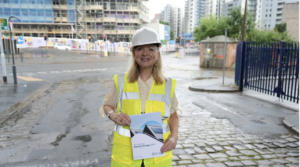A movement for active change in Sheffield
 Something big is happening in Sheffield – we are attempting to reverse a trend that threatens to bankrupt us, as well as make us ill and miserable in the process.
Something big is happening in Sheffield – we are attempting to reverse a trend that threatens to bankrupt us, as well as make us ill and miserable in the process.
And what is this problem? It’s quite simple – most of us have stopped moving enough to keep our bodies working properly.
As a result all the key players in Sheffield – community and voluntary groups, universities and schools , the local authority, NHS and industry – have got together to form a movement for change. We are calling this ‘Move More’ and are creating a culture and environment in our city that makes it easier for people to do just that.
We’ve spent years engineering machines to make life easier for us – cars, computers, washing machines – and accept this as the sign of a sophisticated society. But we need to move. We were designed to. And if we don’t move enough we get ill, physically and mentally. We need to be physically active to help prevent cancer, heart disease, thin bones, painful joints and muscles, depression and anxiety, diabetes and many more illnesses.
We also know if we are physically active we are much more likely to generate wealth – both individually and as a society. We can also decrease our carbon footprint and it costs a lot less to walk or cycle than travel by car. We are generally happier and more relaxed, richer in many senses and live a longer life of better quality – sounds like a ‘no-brainer’.
So why aren’t we doing this? Many people don’t see the relevance to them, and are not motivated to make the effort. Also in our modern, highly-pressured lives, it is often hard to find the time. Culture and environment often work against us, making it harder to fit activity in.
This is why Sheffield has come up with the grand plan to start the mammoth task of reversing this trend. The 2012 Olympics kicked us off, but the city has a history of encouraging sport and physical activity. We have consulted far and wide and I have to thank Dr Rob Copeland from Sheffield Hallam University for pulling it all together.
We will build from the bottom up,
rather than following a top-down approach.
The plan reflects what we are all know – the solution is not simple and is multi-faceted. The whole city has to be behind it, feel like it matters to them, own it and support each other in achieving it. It needs to be inclusive, and take efforts to involve people who might be harder to reach. It needs a whole system approach – because the whole city stands to benefit.
To change behaviour, people need to see the value to them, it should be as enjoyable and interesting as possible and easy to do. For changes to be sustained they need to become a normal everyday habit.
We’re currently exploring an asset-based approach. Rather than the usual agencies dictating to people, we think it works better to build on the ideas, skills and enthusiasm communities and individuals already have. We will build from the bottom up, rather than following a top-down approach. Of course there are ways to support and encourage this process and give people confidence, but building on the assets we already have rather than introducing new ideas is more likely to engage people and communities.
An important consideration is the environment. If people don’t have safe, attractive options to be active it is much harder. Safe cycle routes, well-lit, litter-free paths and building design that supports movement are all crucial. This will take time, but requires the bodies that oversee and commission these city features to be fully engaged and enabled.
Move More involves a high-profile marketing campaign that taps into people’s values, helping them see what is in it for them. These messages need to be consistent, frequent and easy to understand. It helps if people hear this from many sources, so campaigns and regular events – like the forthcoming Communities Got Talent – are part of the plan.
Another key goal is reinforcing the concept that ‘activity is medicine’. We think it will be really helpful if decisionmakers incorporate activity in healthcare pathways. There is a £24m building project happening in Sheffield, to create health clinics within state-of-the art leisure facilities, so people can go to a diabetes or cardiac clinic and step out into the pool or gym. It means the clever money will now follow services that help support people to be active.
The final part of the plan focuses on schools and workplaces as key locations for culture change, where seeds can be planted that affect the whole community. Fitter children tend to achieve better grades. For businesses, healthier staff equals better productivity and bottom line profit. So everyone’s a winner!
Can we do it? Do the people of Sheffield want it? How much fun can we have trying?
This city has the ambition to be the most active city in the UK by the Olympics in 2020…..Come on Sheffield!















